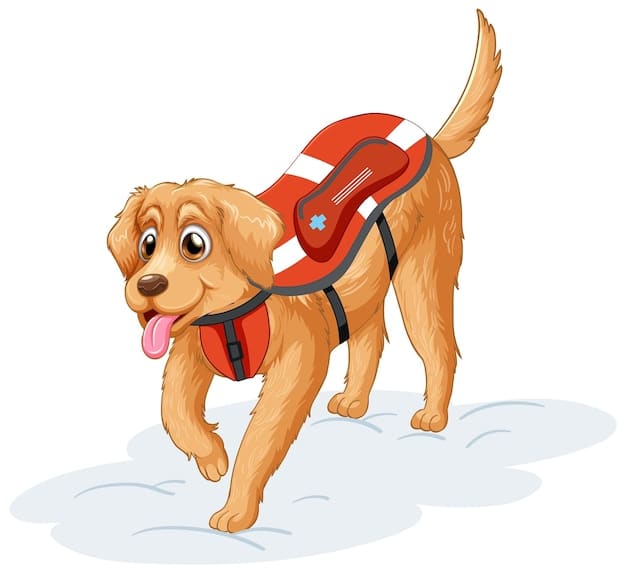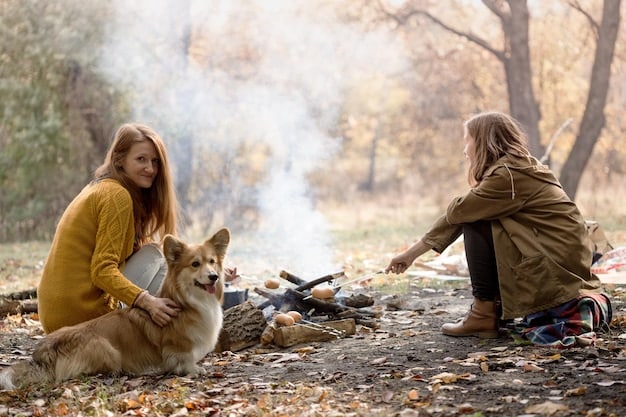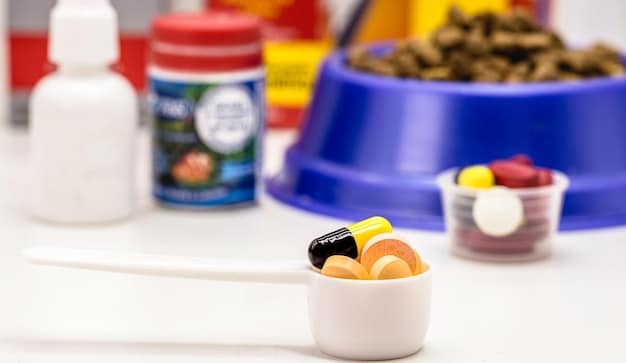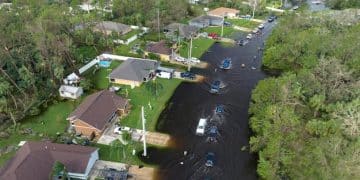Pet Preparedness: Keeping Your Animals Safe During US Disasters

Pet preparedness involves creating a comprehensive plan to protect your animals during disasters in the US, including evacuation strategies, emergency kits, and identification methods.
Natural disasters can strike with little to no warning, making it crucial to have a plan in place for all members of your family, including your pets. Pet preparedness ensures that your animals are safe, healthy, and accounted for during and after a disaster. Let’s explore how to create an effective disaster plan for your furry, scaled, or feathered friends.
Why Pet Preparedness Matters During US Disasters
Disasters can range from hurricanes and wildfires to floods and earthquakes, each posing unique threats to pets. Understanding the importance of preparedness can significantly increase your pet’s chances of survival and well-being.
Ignoring pet preparedness can lead to tragic outcomes. Many shelters are overwhelmed post-disaster, and pets without identification can be difficult to reunite with their owners. A little planning goes a long way in minimizing these risks.
Common Disasters and Their Impact on Pets
Different disasters present different challenges. Here’s a brief overview:
- Hurricanes: Flooding, high winds, and potential for prolonged power outages.
- Wildfires: Smoke inhalation, burns, and evacuation challenges.
- Floods: Drowning, waterborne diseases, and displacement.
- Earthquakes: Structural damage, injuries, and the risk of pets escaping.
Emotional Well-being of Pets During Disasters
It’s not just about physical safety; disasters can also traumatize pets. They may exhibit signs of stress such as hiding, excessive barking, or changes in appetite. A preparedness plan should also consider how to minimize their anxiety.
Having familiar items like toys and bedding can provide comfort during a stressful time. Maintaining a routine as much as possible can also help ease their anxiety.
In summary, pet preparedness is crucial for ensuring the physical and emotional safety of your animals during US disasters. By understanding the unique challenges posed by different types of disasters and taking proactive steps, you can significantly improve your pet’s chances of surviving and thriving.

Creating a Pet Disaster Preparedness Plan
A solid pet disaster plan involves several key components, from identifying evacuation routes to assembling an emergency kit. Let’s break down the essential steps to creating a comprehensive plan.
The first step is to assess the specific risks in your area. Are you in a hurricane-prone region? Do wildfires pose a threat? Tailoring your plan to local hazards is crucial.
Identification and Microchipping
Ensuring your pet has proper identification is paramount. Microchipping is a reliable method, but make sure the information is up-to-date.
- Microchips: Permanent and effective, but requires registration.
- Collars and Tags: Should include your pet’s name, your phone number, and proof of rabies vaccination.
Evacuation Strategies and Routes
Knowing where to go and how to get there is critical. Identify multiple evacuation routes in case one is blocked.
Practice your evacuation plan with your pets. This helps them become familiar with the process and reduces their anxiety during a real emergency.
In conclusion, creating a pet disaster preparedness plan involves assessing risks, ensuring proper identification, and establishing clear evacuation strategies. By taking these steps, you’ll be well-prepared to protect your pets during any disaster.
Building a Pet Emergency Kit
An emergency kit for your pet should include essential supplies to keep them fed, hydrated, and healthy during and after a disaster. Here’s a detailed list of items to include.
Start by gathering all the necessary items in a waterproof and easily transportable container. Label the kit clearly and store it in an accessible location.
Essential Items for Your Pet Emergency Kit
Here’s a checklist of must-have items:
- Food: At least three days’ worth of non-perishable pet food.
- Water: At least three days’ worth of water, plus a collapsible bowl.
- Medications: Any prescription medications your pet needs, along with a copy of their medical records.
- First Aid Kit: Including antiseptic wipes, bandages, and any other items recommended by your veterinarian.
Think of it as a “go bag” tailored to your pet’s specific needs.
Additional Items to Consider
Beyond the essentials, consider adding these items:
Having these items can significantly improve your pet’s comfort and well-being during a disaster.
- Leash and Carrier: Essential for safe transport.
- Toys and Comfort Items: To reduce stress and anxiety.
- Waste Disposal Bags: For sanitary purposes.
- Photo of Your Pet: In case you get separated.
Building a well-stocked pet emergency kit is an essential part of disaster preparedness. By including food, water, medications, and comfort items, you can ensure your pet’s needs are met during an emergency.

Sheltering and Evacuation Considerations for Pets
Knowing where to shelter with your pet and how to evacuate safely is a critical part of your disaster plan. Not all shelters accept pets, so it’s essential to do your research in advance.
Start by identifying pet-friendly shelters in your area. Contact local animal shelters, humane societies, and emergency management agencies for information.
Finding Pet-Friendly Shelters and Hotels
Not all shelters accept pets, so planning is key.
Some hotels also allow pets, but policies can change quickly. Always call ahead to confirm their pet policy and any size or breed restrictions.
- Contact Local Shelters: To inquire about their pet policies.
- Check with Hotels: Many hotels have pet-friendly options.
Safe Evacuation Practices with Pets
When evacuating, follow these guidelines to ensure your pet’s safety:
Evacuating with pets requires careful planning and execution. By identifying pet-friendly shelters, practicing safe evacuation techniques, and keeping your pet calm, you can ensure their safety during a disaster.
- Keep Pets Secure: Use a leash or carrier at all times.
- Stay Calm: Pets can sense your anxiety, so remain composed.
- Bring Your Emergency Kit: Ensure you have all essential supplies.
Training and Acclimation for Disaster Preparedness
Training your pet to respond to commands and acclimate to carriers and other emergency situations can significantly reduce stress during a disaster. Simple training exercises can make a big difference.
Start with basic obedience training. Teach your pet commands like “sit,” “stay,” and “come.” These commands can be invaluable during an evacuation.
Basic Obedience Training for Emergencies
Obedience training can be a lifesaver.
A well-trained pet is more likely to respond calmly and predictably during a disaster.
Regular practice reinforces these skills and prepares your pet for real-life scenarios.
- “Sit” and “Stay”: Helps control your pet in stressful situations.
- “Come”: Essential for recall during an evacuation.
Acclimating Pets to Carriers and Travel
If your pet isn’t used to a carrier, introduce it gradually. Make it a positive experience by placing treats and toys inside.
Take short car rides with your pet in the carrier to get them used to traveling. This can help minimize anxiety during an evacuation.
Training and acclimation are essential components of pet disaster preparedness. By teaching your pet basic obedience commands and acclimating them to carriers and travel, you can reduce their stress and improve their safety during an emergency.
Post-Disaster Care and Recovery for Pets
After a disaster, it’s crucial to prioritize your pet’s physical and emotional well-being. Returning home safely and addressing any health concerns are essential steps.
Before returning home, assess the area for hazards. Look for downed power lines, debris, and contaminated water sources.
Assessing the Environment for Hazards
Safety first when returning home.
By carefully inspecting your property, you can prevent further injuries or illnesses to your pets.
- Check for Structural Damage: Ensure your home is safe to enter.
- Look for Debris: Remove any hazards that could injure your pet.
Addressing Physical and Emotional Trauma
Keep a close eye on your pet for any signs of injury or illness. Contact your veterinarian if you notice anything concerning.
Provide plenty of comfort and reassurance to help your pet cope with the emotional trauma. Maintain a routine as much as possible.
Post-disaster care and recovery are crucial for ensuring your pet’s well-being. By assessing the environment, addressing physical and emotional trauma, and seeking veterinary care when needed, you can help your pet recover and return to normalcy.
| Key Point | Brief Description |
|---|---|
| 🐕 Microchipping | Ensures permanent pet identification with up-to-date contact information. |
| 🎒 Emergency Kit | Contains food, water, meds, and comfort items for at least three days. |
| 🏨 Pet-Friendly Shelters | Identifying and confirming pet-friendly shelters and hotels ahead of time. |
| 훈련 Training | Basic obedience helps manage pets during stressful evacuations and recovery. |
FAQ: Pet Disaster Preparedness
▼
Your pet’s emergency kit should include food, water, medications, a leash, a carrier, comfort items, waste disposal bags, and a photo of your pet. Consider a first-aid kit, too. Having these critical items can ease potential discomfort on your animals
▼
Contact local animal shelters, humane societies, and emergency management agencies for information on pet-friendly shelters. Websites like PetFriendly.com can also help you locate pet-friendly hotels.
▼
Introduce the carrier gradually by placing treats and toys inside. Encourage your pet to enter the carrier voluntarily. Take short car rides with your pet in the carrier to get them used to traveling. This can help with discomfort and anxiety during an emergency
▼
Contact local animal shelters and rescue organizations. Post photos of your pet on social media and local lost pet websites. Check the microchip information is current. Doing all of this will increase your chance to be reunited with your lost animal..
▼
Provide plenty of comfort and reassurance to your pet. Maintain a routine as much as possible. Create a safe and familiar environment with their favorite toys and bedding. Seek veterinary care if your pet exhibits signs of severe stress or trauma.
Conclusion
Prioritizing pet preparedness ensures the safety and comfort of your beloved animals during US disasters. By creating a detailed plan, assembling an emergency kit, and training your pets, you can significantly improve their chances of survival and well-being during any crisis. Remember, a prepared pet is a safer pet.





